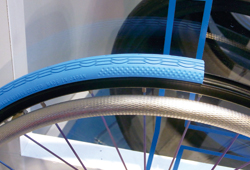Takuma Aoki
A former GP rider active on the world stage in the 1990s, Takuma Aoki was injured in an accident in 1998 and has been confined to a wheelchair ever since. Despite his disability, Mr. Aoki still participates in a number of car racing events for the disabled.
Yokohama Rubber’s tire business is moving forward with the development of eco-friendly tires under the theme protecting the Earth and people around the world in search of further technological innovations. Here, we will take a closer look at the development of a wheelchair tire that can be recycled and is virtually impossible to puncture, which represents one of Yokohama Rubber’s technology-driven social contributions.
For Protecting the Earth and People Around the World
Generally, most wheelchair tires use the same type of inflated tires as bicycles, which require that the tire be able to support weight, have low rolling resistance and be long lasting (including resistance to wear). Inflated tires need to be regularly filled with air and carry with them the risk of punctures, resulting in a number of inconveniences for users.
Yokohama Rubber’s basic philosophy is to enrich people’s lives and contribute to their greater happiness and well-being by devoting our wholehearted energies and advanced technologies. This is why it decided to embark on the development of a recyclable, punctureless wheelchair tire to help mitigate impacts on people and the environment while satisfying the basic requirements.
Overcoming Technical Challenges with Amassed Technological Prowess and Expertise
Today, most rubber, once used, is incinerated as fuel without ever being recycled or reused. Certain products use a small amount of recycled rubber, but rubber’s characteristics are difficult to maintain after recycling. However, Yokohama Rubber recognizes that rubber recycling will be an important way to conserving resources in the future and has begun research into possible methods. As a result, Yokohama Rubber arrived at a heat-based recycling method that uses hydrogen bonding, which makes it possible to reform rubber by heating and cooling it. Today, the company is beginning to partially use this technology.
At the same time, Yokohama Rubber was able to develop a punctureless tire. The capacity of a normal tire to support weight is determined by the volume inside the tire and the air pressure. However, Yokohama Rubber used a method to fill the tire with rubber instead of air, making it completely solid. A solid tire can never be punctured, but it weights more than an inflated tire and lacks the same resiliency, causing greater rolling resistance. In turn, this places a large burden on wheelchair users. To solve this problem, Yokohama Rubber welcomed Takuma Aoki as a development advisor and gathered others together to share ideas and insights, including the use of foamed rubber and innovations in the contact shape of the tire. These ideas are being put to use in solutions.
Aiming to Develop Technologies that can Contribute to the Fields of Healthcare and Welfare
Although still tackling various challenges, Yokohama Rubber is on the verge of commercializing a product that will eliminate the hassle of filling wheelchair tires with air, alleviate concerns over punctures, and reduce stress. The development of a recyclable rubber has brought us one step closer to resolving certain social issues. Going forward, Yokohama Rubber will research the potential of rubber in the fields of healthcare and welfare to create products that protect the Earth and people around the world as well as help resolve social issues.

- A punctureless tire mindful of people and society
- Yokohama Rubber’s punctureless wheelchair tire uses a solid tire that eliminates concerns over punctures and alleviates the stress of users by offering greater ride comfort (resiliency) and operability (reduced rolling resistance).
